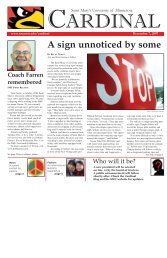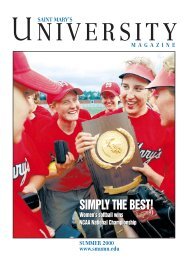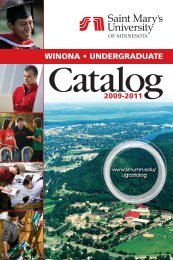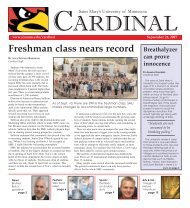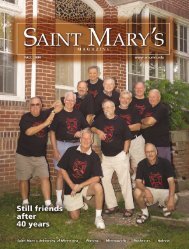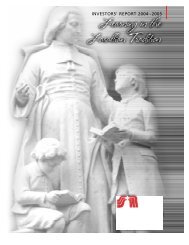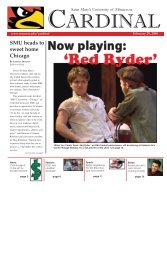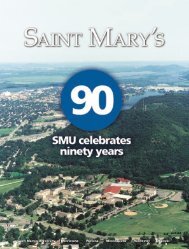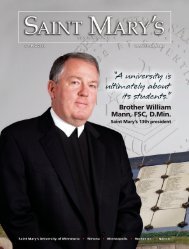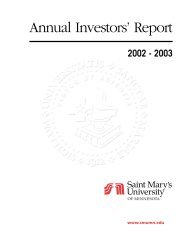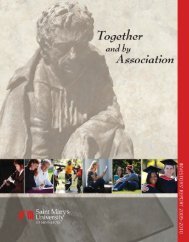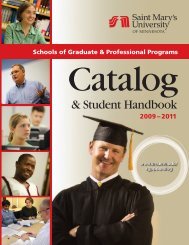PDF version - Saint Mary's University of Minnesota
PDF version - Saint Mary's University of Minnesota
PDF version - Saint Mary's University of Minnesota
You also want an ePaper? Increase the reach of your titles
YUMPU automatically turns print PDFs into web optimized ePapers that Google loves.
History<br />
increase students’ awareness <strong>of</strong> the relationship <strong>of</strong> the U.S. to important issues <strong>of</strong> war and peace as they<br />
unfold in the world. It also pays attention to the linkage between the domestic political environment<br />
and its impact on foreign relations. Furthermore, it looks at important events and crises in U.S. foreign<br />
relations as well as some theories and practices <strong>of</strong> U.S. foreign policies. Students acquire a good set <strong>of</strong><br />
tools to carry on their exploration <strong>of</strong> the impact <strong>of</strong> U.S. foreign policy on the rest <strong>of</strong> the world.<br />
H315 American-East Asian Relations 3 credits<br />
The aim <strong>of</strong> this course is to do three things: provide a general introduction to the history <strong>of</strong> relations<br />
between the United States and the major countries <strong>of</strong> the East Asian cultural sphere (China, Japan,<br />
Korea, and Vietnam); explore the changing images Americans have had <strong>of</strong> the peoples <strong>of</strong> these nations,<br />
the Chinese and Japanese in particular; and draw connections between both these themes and the<br />
experiences <strong>of</strong> Asian-American during the last century-and-a-half <strong>of</strong> American history. Special attention<br />
is paid to crisis in American-East Asian relations, such as: the Boxer Uprising and the 1900 siege <strong>of</strong><br />
Beijing, World War II and the Occupation <strong>of</strong> Japan that followed, the Vietnam War, and contemporary<br />
disputes over issues <strong>of</strong> human rights in China (stemming from the June 4th Massacre <strong>of</strong> 1989). Through<br />
classroom lectures, course readings, and a critical viewing <strong>of</strong> a variety <strong>of</strong> visual materials (including<br />
excerpts from newsreels, newscasts, and feature films) students look at the process by which crisis<br />
involving American interests alter or give new life to enduring Western stereotypes concerning East Asia.<br />
A major goal <strong>of</strong> the course is to provide students with the analytical tools and historical background<br />
necessary to put future crises in U.S.-East Asian relations, as well as the American media’s coverage <strong>of</strong><br />
these crises, in perspective.<br />
H321 The Early Middle Ages 3 credits<br />
The first half <strong>of</strong> a two-semester course that covers the period <strong>of</strong> history from approximately 100 to<br />
approximately 1400, the time <strong>of</strong> the Middle Ages. This course examines the period from approximately<br />
100 to approximately 800. The purpose <strong>of</strong> the course is to identify and explore the concept <strong>of</strong> the<br />
Middle Ages by means <strong>of</strong> both primary and secondary sources. It is a fundamental presupposition that<br />
"Western civilization" came into being during the early Middle Ages out <strong>of</strong> a unique combination <strong>of</strong><br />
Greco-Roman, Judeo-Christian, and Germanic elements. In this sense, then, the Middle Ages represent<br />
not a “middle,” but the beginning <strong>of</strong> a new civilization. The essentials <strong>of</strong> this civilization will be explored.<br />
These include the decline <strong>of</strong> the Roman Empire, the rise <strong>of</strong> Christianity and monasticism, the Barbarian<br />
Invasions, Charlemagne, the Vikings, and the development <strong>of</strong> a feudal society.<br />
H322 The High Middle Ages 3 credits<br />
The second half <strong>of</strong> a two-semester course that covers the period <strong>of</strong> history from approximately 100 to<br />
approximately 1400, the time <strong>of</strong> the Middle Ages. This course examines the period from approximately<br />
1000 to approximately 1400. The purpose <strong>of</strong> the course is to identify and explore the concept <strong>of</strong> the<br />
Middle Ages by means <strong>of</strong> both primary and secondary sources. Out <strong>of</strong> the chaos <strong>of</strong> the tenth century<br />
emerged a mature medieval civilization that is the focus <strong>of</strong> this course. It reached its apogee in the<br />
twelfth and thirteenth centuries with the great conflict between church and state, the Crusades, the<br />
revival <strong>of</strong> learning, feudal monarchy, chivalry, and high medieval Christianity, before experiencing the<br />
disasters <strong>of</strong> the fourteenth century and the breakdown <strong>of</strong> the medieval synthesis.<br />
H332 The Renaissance 3 credits<br />
This course proceeds from the assumption that the Renaissance refers to a particular and creative<br />
cultural movement in Western history from the middle <strong>of</strong> the fourteenth through the sixteenth<br />
centuries. Students explore traditional notions <strong>of</strong> the Renaissance such as: the revival <strong>of</strong> antiquity,<br />
humanism, innovations in art, and the Church. Non-traditional approaches such as the role <strong>of</strong> women<br />
in the Renaissance, are also discussed. The reading <strong>of</strong> primary texts by Petrarch, Castiglione, Machiavelli,<br />
Erasmus, and Thomas More is emphasized. Italian history is stressed but the Northern Renaissance is<br />
studied as well.<br />
114



